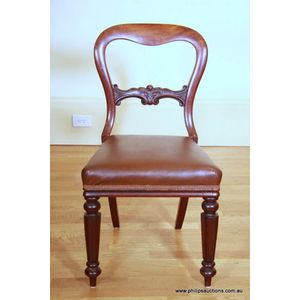William IV Mahogany Carver Chair
You must be a subscriber, and be logged in to view price and dealer details.
Subscribe Now to view actual auction price for this item
When you subscribe, you have the option of setting the currency in which to display prices to $Au, $US, $NZ or Stg.
- Circa - A Latin term meaning 'about', often used in the antique trade to give an approximate date for the piece, usually considered to be five years on either side of the circa year. Thus, circa 1900 means the piece was made about 1900, probably between 1895 and 1905. The expression is sometimes abbreviated to c.1900.
- Scallop / Shell Motif - The shell motif has been used in furniture and decorative arts for centuries. In ancient Greece and Rome, shells were often used as decorative elements on furniture and in mosaics. The scallop or cockleshell are the most commonly used. During the Renaissance, the shell motif became popular in furniture and architecture, as the ornate decoration was seen as a symbol of wealth and luxury. In the 18th century, the Rococo style of furniture and decorative arts featured an abundance of shell motifs, and it was used by Thomas Chippendale and as a feature on Queen Anne style cabriole legs. In the 19th century, the shell motif was incorporated into Victorian furniture and decorative items, and often a representation of the the conch shell was inlaid into furniture.
- Gadrooning - A series of lobes usually as a border. In furniture gadrooning is found as carved decoration around the edges of table tops in the Chippendale and Jacobean style furniture. Gadrooning is also found as decoration on the rims of silver and ceramics.
- Turning - Any part of a piece of furniture that has been turned and shaped with chisels on a lathe. Turned sections include legs, columns, feet, finials, pedestals, stretchers, spindles etc. There have been many varieties and fashions over the centuries: baluster, melon, barley-sugar, bobbin, cotton-reel, rope-twist, and so on. Split turning implies a turned section that has been cut in half lengthwise and applied to a cabinet front as a false decorative support.
- Turned Legs - are legs which have been turned on a lathe. In use from the 16th century, turned legs on tables, chairs and cabinets became more frequent until, by the 1830s, the Georgian square or tapered leg was rarely found except in country pieces.
- Foliate - Decorated with leaves or leaf-like forms.
- William Iv - William IV was King of the United Kingdom and King of Hanover from 26 June 1830 until his death in 1837, and in English furniture design it represented the brief period between the end of the Regency period, and the beginning of the Victorian period.
- Scrolls - Serpentine-shaped forms, used in cabinet construction and decoration for centuries. The scroll appears in legs, feet, as carving in chair brackets, chair rails and arms. The deeper and more spontaneous the carving is, the earlier the piece is likely to be. The Regency or 'Thomas Hope' scroll, used on pediments and sideboard backs, consists of two scrolls on the horizontal plane, placed back to back in a mirror image, and sometimes decorated with a variety of carved and/or applied ornament, such as shells, foliate and other motifs. Chippendale-style furniture is often distinguished by two corresponding scrolls in the form of a 'C' in the upper splat or where chair legs join the seat rail.
- Mahogany - Mahogany is a dense, close grained red-coloured timber from the West Indies and Central America. It was first imported into Europe in the the early 18th century and its use continued through the 19th century. It was popular for furniture making because of its strength, the wide boards available, the distinctive grain on some boards, termed flame mahogany and the rich warm colour of the timber when it was polished.. The "flame" was produced where a limb grew out from the trunk of the tree, and this timber was usually sliced into veneers for feature panels on doors, backs and cornices.
Some terms used to describe mahogany relate to the country from which it originally came, such as "Cuban" mahogany, "Honduras" mahogany etc. However unless the wood has been tested the names assigned are more a selling feature, rather than a true indication of the timber's origin. - Proportions - Essentially, the size of the various parts of a piece of furniture in relation to the whole. Ideally, the proportions should be pleasing to the eye appearing neither top-heavy nor unbalanced and convenient for ordinary use.
- Rail - A term used by cabinet makers for the horizontal sections of the frame of an item such as a chair or settee which have a front rail, a back rail and two side rails, and also on a door or carcase, where the rails are joined to the vertical framings.
This item has been included into following indexes:
-
chairs, singles / pairs / threes, style or period
- carver or elbow chairs 246
- William IV 122
- chairs, singles / pairs / threes, timber - mahogany 1,098
Visually similar items

A set of six Victorian mahogany balloon back chairs, circa 1880s, with rounded cresting rails with scroll embellishments and a foliate mid rail, with stuff over seats and upon baluster shaped turned legs, upholstered in sage velvet. Height 89 cm

A fine set of eight early Victorian Spoonback chairs, 19th century, of elegant waisted form with broad cresting rails with pierced and carved acanthus embellishments, a scroll and ruyi fungus decorated mid rail, stuffover serpentine seats and raised on car

A set of four Victorian mahogany balloon back chairs, 19th century, the waisted chairs with a foliate carved mid rail above a square stuffover seat, upholstered in deep maroon/brown leatherette and raised upon knopped and fluted baluster legs and toupie fe

A Victorian marble top dressing table
